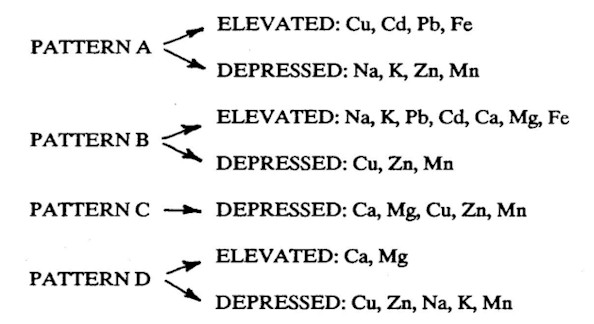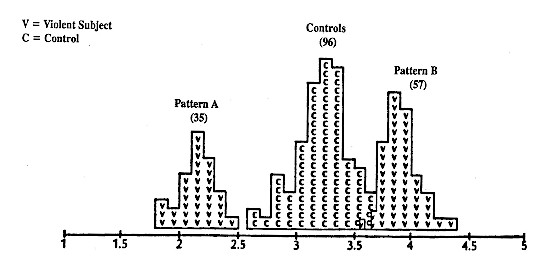CHEMICAL IMBALANCES AND CRIMINAL VIOLENCE
by
William J. Walsh, PhD, President, Health Research Institute
For centuries, research aimed at reducing the incidence of criminal violence has largely failed. Literally hundreds of psychoanalytic techniques, behavior modification systems, and experimental drug therapies have been attempted, and none has proven to be effective. The sad truth is that most violent criminals become recidivists, whether they participate in rehabilitation programs or not. Society simply doesnít know how to remediate its criminal population, and the national trend is toward longer sentences and increased application of the death penalty.
Criminologists still debate whether the predominant cause is psychological, sociological, biological, or something else. Another barrier to progress is the fact that criminal violence is not a single condition, but rather a diverse set of afflictions.
The lack of progress in combating crime and violence has resulted from several factors. First and foremost, there is no clear understanding of the basic causes of violence and antisocial behavior. Criminologists still debate whether the predominant cause is psychological, sociological, biological, or something else. Another barrier to progress is the fact that criminal violence is not a single condition, but rather a diverse set of afflictions. The inadequacy of classification methods for separating criminals into appropriate groups has hindered progress over a century.
A ray of hope has been provided by twin and adoption studios is Scandinavia, which present the first solid evidence of an inborn predisposition to criminality. Christiansen made a survey of nine twin-criminality studies.1 In these studies, identical (monozygotic) and fraternal (dizygotic) twins were compared with respect to "concordance" of criminality between the two groups. Wilson and Herrnstein2 pooled Christiansesís and other data and found identical twins to have concordance of 0.69, compared to only 0.33 for same-sex fraternal twins. This result clearly indicates a substantial genetic component in criminal behavior.
. . . a separate adoption study . . . found that sons whose biological parents had a criminal record were four times as likely to have a serious criminal record, compared with those without familial criminality.
Mednick et al.3 evaluated Scandinavian adoption records focusing on cases in which a biological parent or adoptive parent evidenced criminality. Their evaluation showed a strong relationship between criminality of biological parents and their sons. In a separate adoption study, Cloninger et al4 found that sons whose biological parents had a criminal record were four times as likely to have a serious criminal record, compared with those without familial criminality. This effect far exceeded the effects of environmental factors studied including adoptive parent criminality, child abuse, and poverty.
The Health Research Institute has observed distinctive chemical imbalances in violent subjects5 and has developed the classification system6 based on hair chemistry as shown in the accompanying table.

Distinctive Chemical Imbalances Observed in Criminals
The Type A and B patterns were discovered in a sibling experiment involving 24 pairs of brothers, ranging in age from 8 to 18 years. Each of the sibling pairs included an extremely delinquent, violent brother and a brother who was an "all-American boy" with no history of behavioral or academic problems. The violent siblings were found to possess the Type A or Type B imbalances whereas the controls did not. This result was confirmed in a field test involving 96 extremely violent persons and 96 nonviolent controls, the two groups balanced with respect to age, race, and socioeconomic level as a child. The accompanying figure displays these groupings.
These distinctive patterns have been found in violent subjects of all races, age groups, and socioeconomic levels.
Subsequent testing of general delinquent populations revealed that C and D type hair-chemistry patterns (see the table) are common to persons exhibiting low-to-intermediate aggressiveness. Two recent double-blind experiments in California (with 90 and 198 subjects, respectively) have confirmed the high incidence of the A/B/C/D patterns in criminal populations and their low incidence in the general population. These distinctive patterns have been found in violent subjects of all races, age groups, and socioeconomic levels. Studies of mass murderers and serial killers (including Charles Manson, Henry Lee Lucas, James Huberty, and Patrick Sherrill) have revealed intense A or B patterns to be present in most cases.
Clinical studies of violent persons exhibiting the A/B/C/D hair-chemistry patterns have been performed by NOHA Honorary Member Carl C. Pfeiffer, MD, PhD, and others at the Brain Bio Center in Princeton, New Jersey and elsewhere. Type B subjects are the most uniform, exhibiting elevated kryptopyrrole (decomposition product of vitamin B6 and zinc) in urine; depressed spermine, zinc, and manganese in blood; and elevated blood lead, along with high histamine levels and hypoglycemia. Dr. Pfeiffer has named kryptopyrrole in urine "pyroluria." Type A subjects are generally found to have a histamine disorder; elevated copper and lead in blood; and zinc deficiency, with about 40 percent exhibiting pyroluria and/or hypoglycemia. Most Type C subjects are very slender, and malabsorption is usually the only chemical imbalance found. At this writing, 100 percent of all Type D subjects have been observed to be hypoglycemic, although many are also malabsorbers.

Field Test Data, Using a Discriminate Function Based on Na,
Zn, and Cu ppm Concentrations
Approximately 200 Type A, B, C, or D subjects have been placed on individualized treatment programs to correct the specific chemical imbalances observed. These treatments (designed by Dr. Pfeiffer) consist of vitamin, mineral, and amino acid supplements, together with dietary recommendations. The treatments are quite different for each body chemistry type, and great care must be taken in characterizing each subject. The optimum treatment for a Type A person would probably worsen the condition of a Type B person. Indiscriminate dosing of delinquent populations with multivitamins appears to be harmful to Type Aís, neutral to Type Bís, and beneficial to Type C and D. Because of the potential for making a serious condition worse, individualized treatment programs should be designed by experienced medical professionals.
. . . subjects have been placed on individualized treatment programs to correct the specific chemical imbalances observed. These treatments . . . consist of vitamin, mineral, and amino acid supplements, together with dietary recommendations. The treatments are quite different for each body chemistry type, and great care must be taken in characterizing each subject. . . . surveys of parents, teachers, and counselors show that more than 75 percent of the treated subjects report a "significant improvement," with best results obtained with children.
Confidential surveys of parents, teachers, and counselors show that more than 75 percent of the treated subjects report a "significant improvement," with best results obtained with children. Since this information is anecdotal, these treatments must be regarded as unproven until double-blind, controlled experiments measuring treatment effectiveness is done. The Health Research Institute plans to begin two such experiments in California in 1988.
The "nature vs. nurture" debate still continues in the field of criminology. However, the evidence is mounting that both factors are important ingredients in forming criminal personality. The principal cause of violent crime appears to be a biochemical predisposition triggered by environmental stress. The eventual solution to this critical societal problem may lie in the fields of biochemistry and nutrition.
_______________________
1Christiansen, K.O., "A review of studies of criminology among twins," in S.A. Mednick and K. O. Christiansen (eds.), Biosocial Bases of Criminal Behavior, New York: Wiley, 1977.
2Wilson, J.Q., and R. J. Herrnstein, Crime and Human Nature, New York: Simon and Schuster, 1986, pp. 90-95.
3Mednick, S. A., W. F. Gabrielli Jr., and B. Hutchings, "Genetic influences in criminal convictions: Evidence from an adoption cohort," Science 224:891-94, 1984.
4Cloninger, C. R., S. Sigvardsson, M. Bohman, and A. L. von Knorring, "Predisposition to petty criminality in Swedish adoptees. II. cross-fostering analysis of gene-environment interaction," Archives of General Psychiatry 39:1242-47,1982.
5Raloff, J., "Locks Ė A key to violence?" Science News, 124:122-25, 1983.
6Walsh, W, J., "Chemical Classification of Violent Criminals," Report No. HRI-104-3, 37th Annual meeting of the American Chemical Society, San Diego, 1985.
Article from NOHA NEWS, Vol. XIII, No. 2, Spring 1988, pages 3-4.